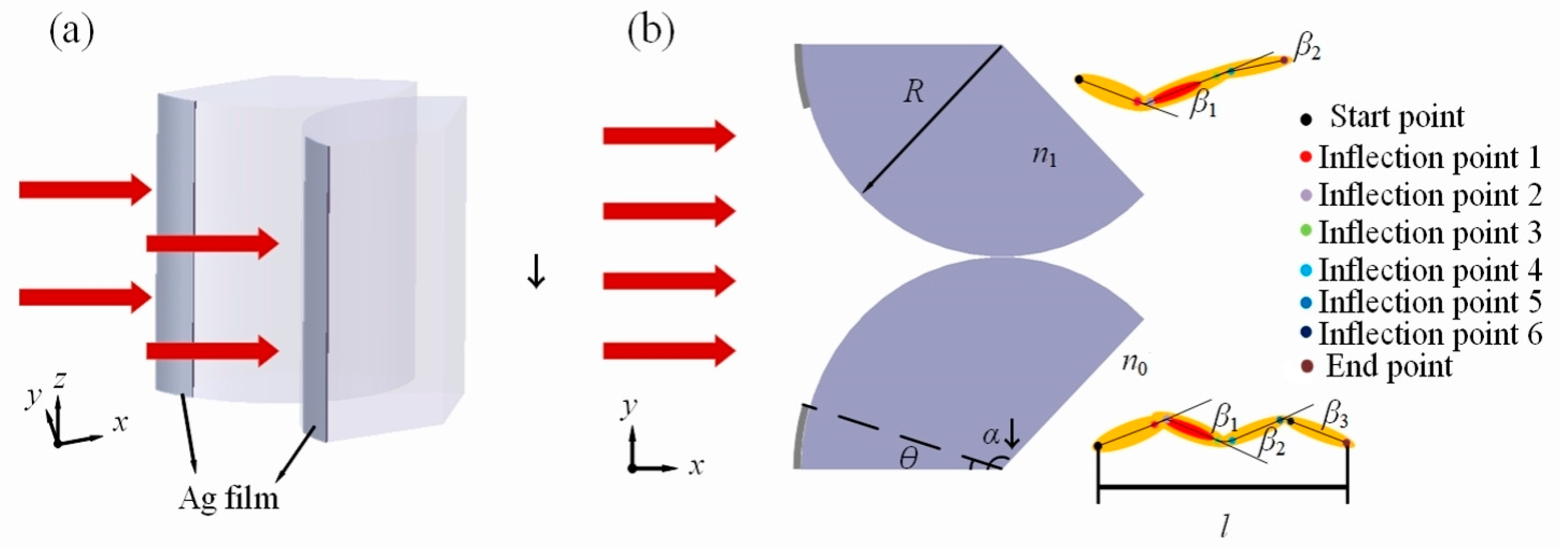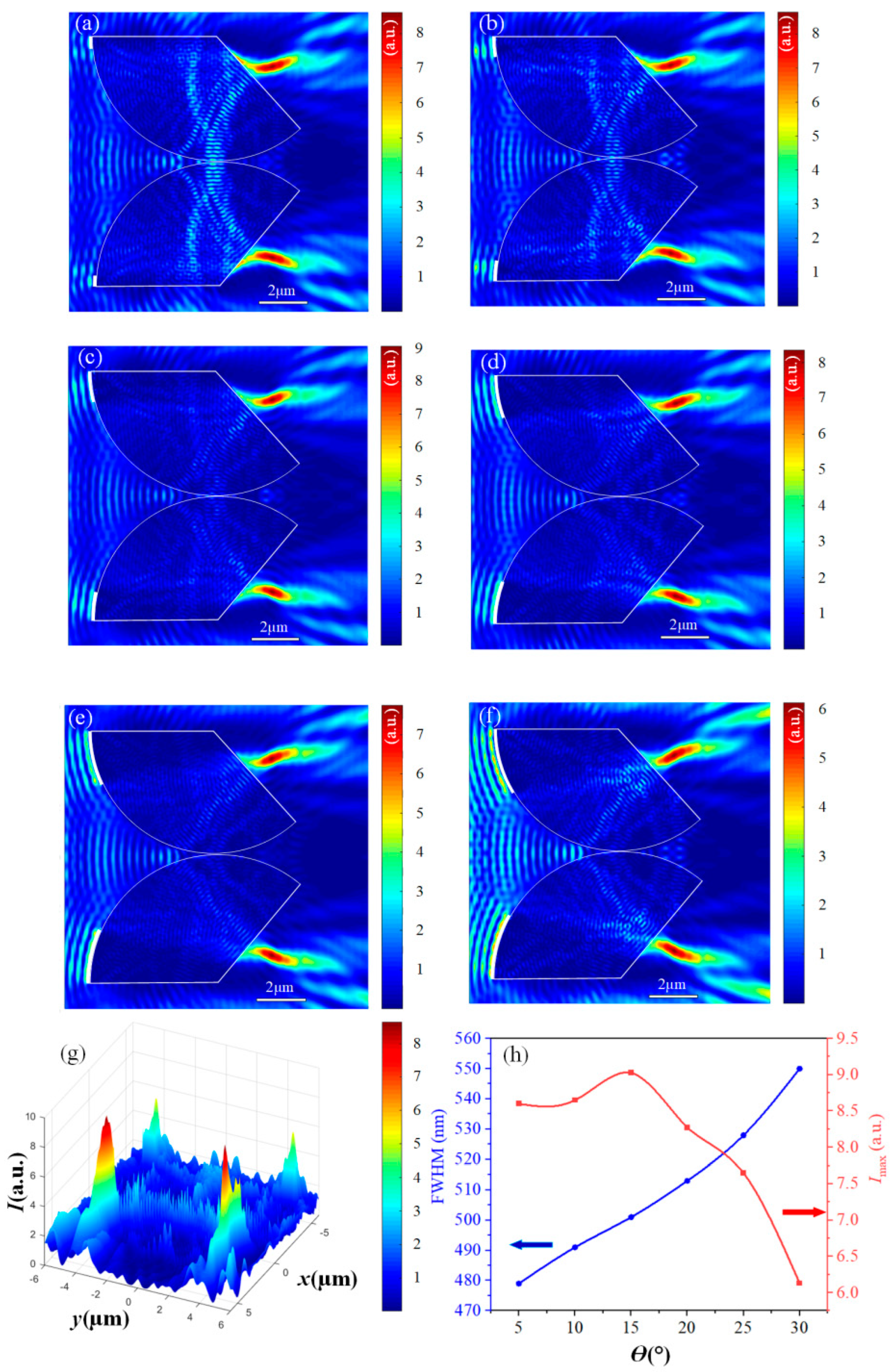Morphologically Switchable Twin Photonic Hooks
Abstract
1. Introduction
2. Materials and Methods
3. Results and Discussion
3.1. Comparison with and without Ag Films
3.2. Influence of Difference Opening Angles
3.3. The Influence of Ag Films Coverage Angle
4. Conclusions
Author Contributions
Funding
Institutional Review Board Statement
Informed Consent Statement
Data Availability Statement
Conflicts of Interest
References
- Kong, S.C.; Sahakian, A.; Taflove, A.; Backman, V. Photonic nanojet-enabled optical data storage. Opt. Express 2008, 16, 13713–13719. [Google Scholar] [CrossRef] [PubMed]
- Cui, X.; Erni, D.; Hafner, C. Optical forces on metallic nanoparticles induced by a photonic nanojet. Opt. Express 2008, 16, 13560–13568. [Google Scholar] [CrossRef] [PubMed]
- Yang, H.; Moullan, N.; Auwerx, J.; Gijs, M.A.M. Super-Resolution Biological Microscopy Using Virtual Imaging by a Microsphere Nanoscope. Small 2013, 10, 1712–1718. [Google Scholar] [CrossRef] [PubMed]
- Minin, I.V.; Minin, O.V. Diffractive Optics and Nanophotonics: Resolution below the Diffraction Limit; Springer: Cham, Switzerland, 2016. [Google Scholar]
- Rubio, C.; Tarrazó-Serrano, D.; Minin, O.V.; Uris, A.; Minin, I.V. Acoustical hooks: A new subwavelength self-bending beam. Results Phys. 2020, 16, 102921. [Google Scholar] [CrossRef]
- Salandrino, A.; Christodoulides, D.N. Airy plasmon: A nondiffracting surface wave. Opt. Lett. 2010, 35, 2082. [Google Scholar] [CrossRef]
- Gu, G.; Shao, L.; Song, J.; Qu, J.; Zheng, K.; Shen, X.; Peng, Z.; Hu, J.; Chen, X.; Chen, M.; et al. Photonic hooks from Janus microcylinders. Opt. Express 2019, 27, 37771–37780. [Google Scholar] [CrossRef]
- Safaie, N.; Ferrier, R.C. Janus nanoparticle synthesis: Overview, recent developments, and applications. J. Appl. Phys. 2020, 127, 170902. [Google Scholar] [CrossRef]
- Pacheco-Peña, V.; Riley, J.A.; Liu, C.Y.; Minin, O.V.; Minin, I.V. Diffraction limited photonic hook via scattering and diffraction of dual-dielectric structures. Sci. Rep. 2021, 11, 20278. [Google Scholar] [CrossRef]
- Tang, F.; Shang, Q.; Yang, S.; Wang, T.; Melinte, S.; Zuo, C.; Ye, R. Generation of photonic hooks from patchy microcylinders. Photonics 2021, 8, 466. [Google Scholar] [CrossRef]
- Minin, I.V.; Minin, O.V.; Liu, C.Y.; Wei, H.-D.; Geints, Y.E.; Karabchevsky, A. Experimental demonstration of tunable photonic hook by partially illuminated dielectric microcylinder. Opt. Lett. 2020, 45, 4899–4902. [Google Scholar] [CrossRef]
- Minin, O.V.; Minin, I.V. The Photonic Hook: From Optics to Acoustics and Plasmonics; Springer: Cham, Switzerland, 2021. [Google Scholar]
- Minin, O.V.; Minin, I.V.; Cao, Y. Time domain self-bending photonic hook beam based on freezing water droplet. Sci. Rep. 2023, 13, 7732. [Google Scholar] [CrossRef] [PubMed]
- Zhang, Y.; Tang, H.; Shi, Z.; Li, R.; Wei, B.; Yan, B.; Minin, I.V.; Minin, O.V. Photonic hooks generated by a rotating dielectric sphere: Nanophotonics. SPIE 2023, 12961, 49–57. [Google Scholar]
- Gu, G.Q.; Zhang, P.; Chen, S.; Zhang, Y.; Yang, H. Inflection point: A perspective on photonic nanojets. Photonics Res. 2021, 9, 1157–1171. [Google Scholar] [CrossRef]
- Xu, C.; Ye, R.; Zou, P.; Yang, T.; Melinte, S.; Wang, Z.; Zuo, C. Focusing light with a metal film coated patchy particle. Opt. Express 2023, 31, 10894–10904. [Google Scholar] [CrossRef] [PubMed]
- Poteet, A.; Zhang, X.A.; Nagai, H.; Chang, C.-H. Twin photonic nanojets generated from coherent illumination of microscale sphere and cylinder. Nanotechnology 2018, 29, 075204. [Google Scholar] [CrossRef] [PubMed]
- Liu, C.Y.; Yeh, M.J. Experimental verification of twin photonic nanojets from a dielectric microcylinder. Opt. Lett. 2019, 44, 3262–3265. [Google Scholar] [CrossRef]
- Zhou, S. Twin photonic hooks generated from two adjacent dielectric cylinders. Opt. Quantum Electron. 2020, 52, 389. [Google Scholar] [CrossRef]
- Yang, Y.J.; Zhang, D.L.; Hua, P.R. Array of photonic hooks generated by multi-dielectric structure. Opt. Laser Technol. 2023, 157, 108673. [Google Scholar] [CrossRef]
- Chen, B.; Wei, K.; Cheng, Y.; Su, N.; Xu, Y.; Wu, P. Tunable twin photonic hooks generated by a double-layer fan-shaped microcylinder. Opt. Commun. 2024, 550, 129963. [Google Scholar] [CrossRef]
- Taflove, A.; Hagness, S.C. Computational Electrodynamics: The Finite Difference Time Domain Method; Artech House: Boston, MA, USA, 1998. [Google Scholar]
- Wang, F.; Liu, L.; Yu, H.; Wen, Y.; Yu, P.; Liu, Z.; Wang, Y.; Li, W.J. Scanning superlens microscopy for non-invasive large field-of-view visible light nanoscale imaging. Nat. Commun. 2016, 7, 13748. [Google Scholar] [CrossRef]
- Yan, B.; Yue, L.; Monks, J.N.; Yang, X.; Xiong, D.; Jiang, C.; Wang, Z. Superlensing plano-convex-microsphere (PCM) lens for direct laser nano-marking and beyond. Opt. Lett. 2020, 45, 1168–1171. [Google Scholar] [CrossRef] [PubMed]
- Li, W.B.; Zhou, D.; Xu, R.; Wang, D.-W.; Su, J.-Z.; Pang, L.-X.; Liu, W.-F.; Chen, G.-H. BaTiO3-Based Multilayers with Outstanding Energy Storage Performance for High Temperature Capacitor Applications. ACS Appl. Energy Mater. 2019, 2, 5499–5506. [Google Scholar] [CrossRef]
- Liu, C.; Chung, H.; Hsuan, P. Reflective photonic hook achieved by a dielectric-coated concave hemicylindrical mirror. J. Opt. Soc. Am. B 2020, 37, 2528–2533. [Google Scholar] [CrossRef]
- Han, Z.; Bozhevolnyi, S.I. Radiation guiding with surface plasmon polaritons. Rep. Prog. Phys. 2013, 76, 016402. [Google Scholar] [CrossRef] [PubMed]
- Minin, I.V.; Minin, O.V.; Ponomarev, D.S.; Glinskiy, I.A. Photonic hook plasmons: A new curved surface wave. Ann. Phys. 2018, 530, 1800359. [Google Scholar] [CrossRef]
- Minin, I.V.; Minin, O.V.; Glinskiy, I.A.; Khabibullin, R.A.; Malureanu, R.; Lavrinenko, A.V.; Yakubovsky, D.I.; Arsenin, A.V.; Volkov, V.S.; Ponomarev, D.S. Plasmonic nanojet: An experimental demonstration. Opt. Lett. 2020, 45, 3244–3247. [Google Scholar] [CrossRef]




| Angle of Silver Films | β1 | β2 | β3 |
|---|---|---|---|
| 5° | 51.3° | 36.4° | 41.8° |
| 10° | 50.5° | 35.3° | 41.6° |
| 15° | 48.2° | 21.1° | 13.6° |
| 20° | 47.6° | 13.3° | 12.8° |
| 25° | 34.1° | 19.5° | / |
| 30° | 33.6° | 29.2° | / |
Disclaimer/Publisher’s Note: The statements, opinions and data contained in all publications are solely those of the individual author(s) and contributor(s) and not of MDPI and/or the editor(s). MDPI and/or the editor(s) disclaim responsibility for any injury to people or property resulting from any ideas, methods, instructions or products referred to in the content. |
© 2024 by the authors. Licensee MDPI, Basel, Switzerland. This article is an open access article distributed under the terms and conditions of the Creative Commons Attribution (CC BY) license (https://creativecommons.org/licenses/by/4.0/).
Share and Cite
Shi, Z.; Wei, K.; Wu, P.; Chen, B.; Fan, S. Morphologically Switchable Twin Photonic Hooks. Materials 2024, 17, 4695. https://doi.org/10.3390/ma17194695
Shi Z, Wei K, Wu P, Chen B, Fan S. Morphologically Switchable Twin Photonic Hooks. Materials. 2024; 17(19):4695. https://doi.org/10.3390/ma17194695
Chicago/Turabian StyleShi, Zejie, Kaihua Wei, Pinghui Wu, Bohuan Chen, and Shanhui Fan. 2024. "Morphologically Switchable Twin Photonic Hooks" Materials 17, no. 19: 4695. https://doi.org/10.3390/ma17194695
APA StyleShi, Z., Wei, K., Wu, P., Chen, B., & Fan, S. (2024). Morphologically Switchable Twin Photonic Hooks. Materials, 17(19), 4695. https://doi.org/10.3390/ma17194695






